The Glucoamylase Market is estimated to be valued at USD 909.2 million in 2025 and is projected to reach USD 1398.5 million by 2035, registering a compound annual growth rate (CAGR) of 4.4% over the forecast period.
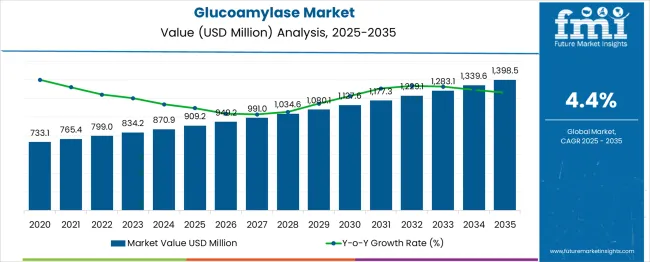
The glucoamylase market is advancing steadily, shaped by rising demand in the food and beverage, biofuel, and industrial enzyme sectors. The shift toward efficient starch conversion processes and the growing emphasis on sustainable production practices are influencing market growth.
Advancements in fermentation technology and improvements in enzyme yield and stability are creating avenues for cost reduction and wider adoption. The increasing utilization of glucoamylase in starch-based sugar production and bioethanol manufacturing is supporting its growing significance in both mature and emerging economies.
Future growth is expected to be bolstered by innovations in strain development, optimization of fermentation techniques, and alignment with environmental and energy efficiency goals. Collaborative efforts between enzyme producers and end-use industries are paving the way for enhanced applications and market penetration.
The market is segmented by Source, Product Type, and Application and region. By Source, the market is divided into Microorganisms, Plants, and Animals. In terms of Product Type, the market is classified into Liquid State Fermentation and Solid State Fermentation. Based on Application, the market is segmented into Starch Sugar, Beer, Alcohol, White Spirit, and Others. Regionally, the market is classified into North America, Latin America, Western Europe, Eastern Europe, Balkan & Baltic Countries, Russia & Belarus, Central Asia, East Asia, South Asia & Pacific, and the Middle East & Africa.
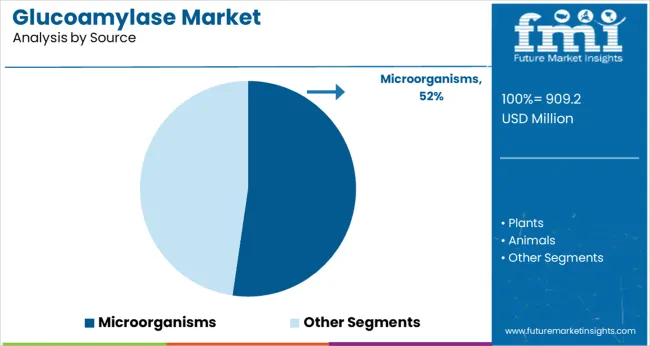
When segmented by source, the microorganisms segment is expected to hold 52.3% of the total market revenue in 2025, making it the leading source category. This dominance has been driven by the superior yield, scalability, and cost-effectiveness of microorganism-derived glucoamylase compared to plant or animal sources.
Microbial production has enabled consistent quality and higher enzyme activity levels, which are critical in industrial starch conversion processes. Additionally, advances in genetic engineering have allowed optimization of strains to enhance productivity and resilience, further reinforcing the preference for microorganisms.
The ability to sustain large-scale fermentation and meet stringent industrial performance standards has cemented the leadership of this segment.
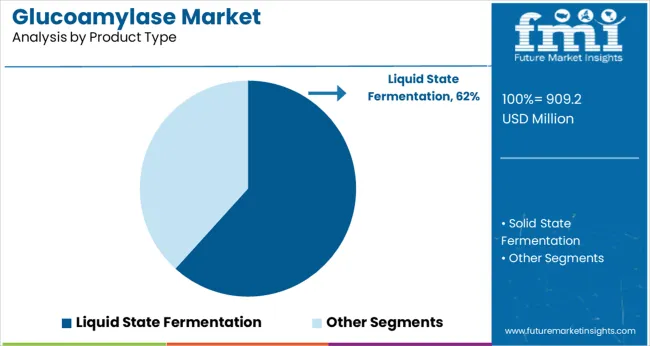
Segmented by product type, liquid state fermentation is projected to account for 61.7% of the market revenue in 2025, positioning it as the leading product type. This position has been secured by its efficiency in producing high yields, ease of scaling, and ability to support controlled fermentation conditions.
Liquid state processes have enabled greater flexibility in optimizing pH, temperature, and nutrient supply, resulting in improved enzyme output and functionality. The lower operational complexity and adaptability to various production scales have further driven its adoption.
Enhanced process control and compatibility with modern bioreactors have made liquid state fermentation the preferred choice for industrial-scale glucoamylase production.
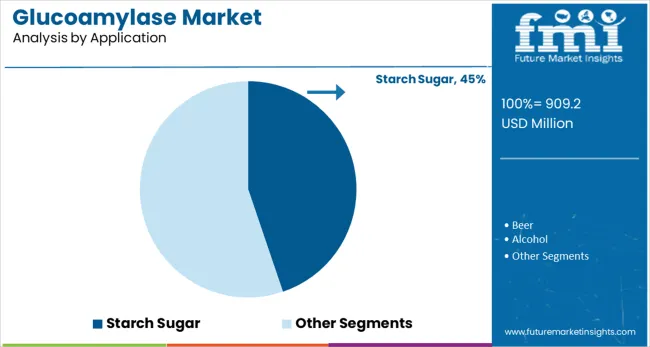
When segmented by application, starch sugar is expected to command 44.8% of the market revenue in 2025, maintaining its position as the top application area. This prominence has been reinforced by the widespread use of glucoamylase in converting starch into glucose syrup and high-fructose syrups, which are in high demand across the food and beverage industry.
The cost efficiency and effectiveness of glucoamylase in achieving desired sweetness profiles and texture have made it indispensable in starch sugar production. The growth of confectionery, bakery, and processed food sectors has amplified the need for high-quality starch sugars, further cementing this segment’s leadership.
Rising consumer preference for sweeteners derived from natural and renewable sources has also contributed to the sustained dominance of starch sugar as the primary application.
The value of the global market for Glucoamylase expanded from USD 632.2 to USD 789.2 between 2020 and 2025, growing at a CAGR of 5.7%.
The global Glucoamylase market is expected to experience significant growth in the coming years, making it an attractive option for investors.
Historically, Glucoamylase has been used in various industrial applications such as food and beverage processing, animal feed production, and medicine manufacturing. In recent years, its use has expanded to include biofuel production and biorefinery processes due to its efficiency at breaking down starch-based materials.
The global Glucoamylase Market is forecast to grow at a solid CAGR of 4.4% from USD 909.2 billion in 2025 to USD 1,283.1 billion by 2035.
Why does the United States hold a dominant position in the market for Glucoamylase?
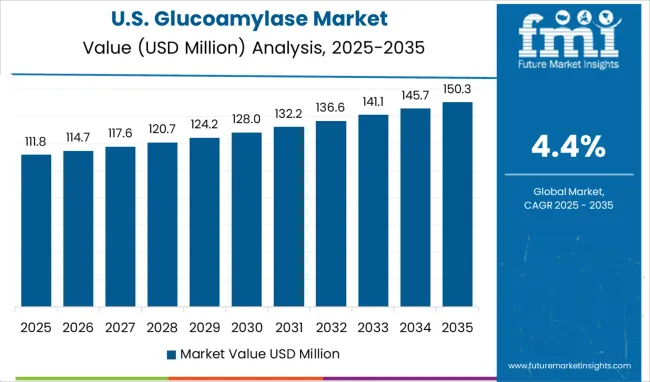
The USA accounted for 32.2% of the North American market with a value of USD 909.2 million in 2025. The United States has long been known as an economic powerhouse. In the market for Glucoamylase, it holds a dominant position in terms of production and sales.
Though the USA is not the sole producer of Glucoamylase, its companies have invested heavily in research and development to produce higher yields of this essential enzyme. This investment has resulted in more efficient production processes that have enabled American companies to offer competitive prices while maintaining quality standards that are difficult to match elsewhere in the world.
The China Brewing Boiler Market will grow at 3.7% CAGR between 2025 and 2035. The global Glucoamylase market is experiencing growth due to increased demand for food and beverage products in China.
This development has been driven by the country's expanding population, rising incomes, and changing diet preferences. With more people consuming processed foods such as bakery goods and noodles, the need for Glucoamylase has surged.
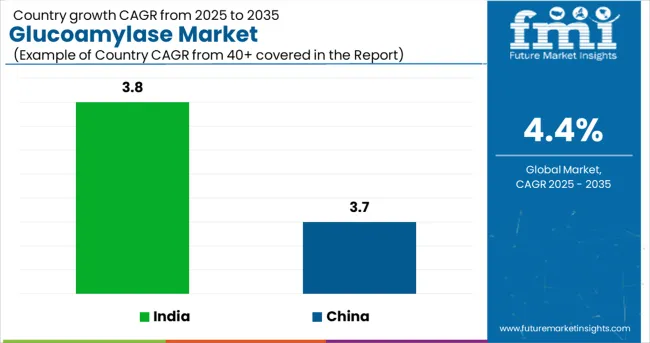
The India Brewing Boiler Market will grow at 3.8% CAGR between 2025 and 2035. India is one of the world's top producers of Glucoamylase, a complex enzyme used in the production of beer and other food products. The market for Glucoamylase in India is large and growing, as more breweries are being set up across the country. India currently holds a significant portion of the global Glucoamylase market share, with local manufacturers contributing significantly to this success.
Glucoamylase is a commonly used enzyme in the food industry. It has many applications, meaning it can be utilized in various aspects of food production and processing. It is widely used to hydrolyze starches and convert them into glucose, which can then be used for various purposes such as fermentation, alcohol production, or sweetening purposes.
Glucoamylase also has applications in baking goods, as well as alcoholic beverages like beer and cider. When added to the dough before baking the enzyme helps break down starch molecules into smaller components that result in fluffier bread and pastries with more volume than traditional recipes. Similarly, when added to beer or cider during fermentation it increases the number of fermentable sugars present which leads to higher alcohol yields.
In recent years, the demand for Glucoamylase has increased significantly due to the emergence of plant-sourced Glucoamylase. Glucoamylase is an enzyme used in industrial food processing and fermentation processes to break down complex sugars into simpler forms.
Plant-sourced Glucoamylase offers advantages over microbial sources such as greater stability and cost savings. As a result, more companies are turning to plant-sourced Glucoamylase as a cost-effective alternative for their production needs.
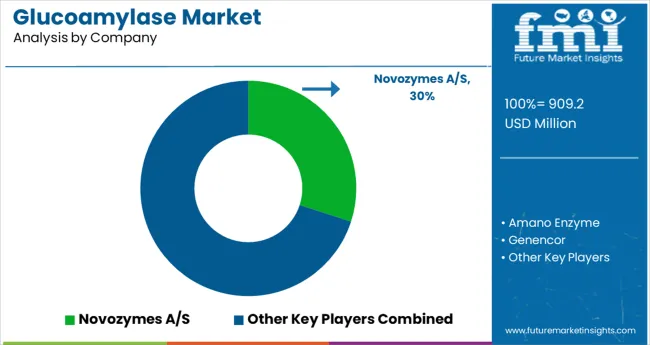
This market is highly competitive and producers of Glucoamylase must be aware of the current trends in the industry in order to remain successful. Glucoamylase is used widely in the production of starch and food processing industries. As such, there are a number of key players in this market providing their own versions of Glucoamylase.
| Attribute | Details |
|---|---|
| Forecast Period | 2025 to 2035 |
| Historical Data Available for | 2020 to 2025 |
| Market Analysis | USD million for Value and Units for Volume |
| Key Regions Covered | North America; Latin America; Europe; Asia Pacific; Oceania; Middle East and Africa (MEA) |
| Key Countries Covered | USA, Mexico, Canada, Germany, the United Kingdom, France, Italy, Spain, India, Japan, China, South Korea, Australia, Argentina, Brazil, South Africa, UAE |
| Key Segments Covered | Source, Product Type, Application, Region |
| Key Companies Profiled | Novozymes; Amano Enzyme; Genencor; AB Enzyme; DSM; Shandong Longda; Jinyuan; Verenium; Sunson; Challenge Group; BESTZYME BIO-ENGINEERING CO., LTD; Wuhan Sunhy Biology Co., Ltd |
| Report Coverage | Company Share Analysis, DROT Analysis, Market Dynamics and Challenges, Strategic Growth Initiatives, Market Forecast, Competitive Landscape |
| Customization & Pricing | Available upon Request |
The global glucoamylase market is estimated to be valued at USD 909.2 million in 2025.
It is projected to reach USD 1,398.5 million by 2035.
The market is expected to grow at a 4.4% CAGR between 2025 and 2035.
The key product types are microorganisms, plants and animals.
liquid state fermentation segment is expected to dominate with a 61.7% industry share in 2025.

Thank you!
You will receive an email from our Business Development Manager. Please be sure to check your SPAM/JUNK folder too.